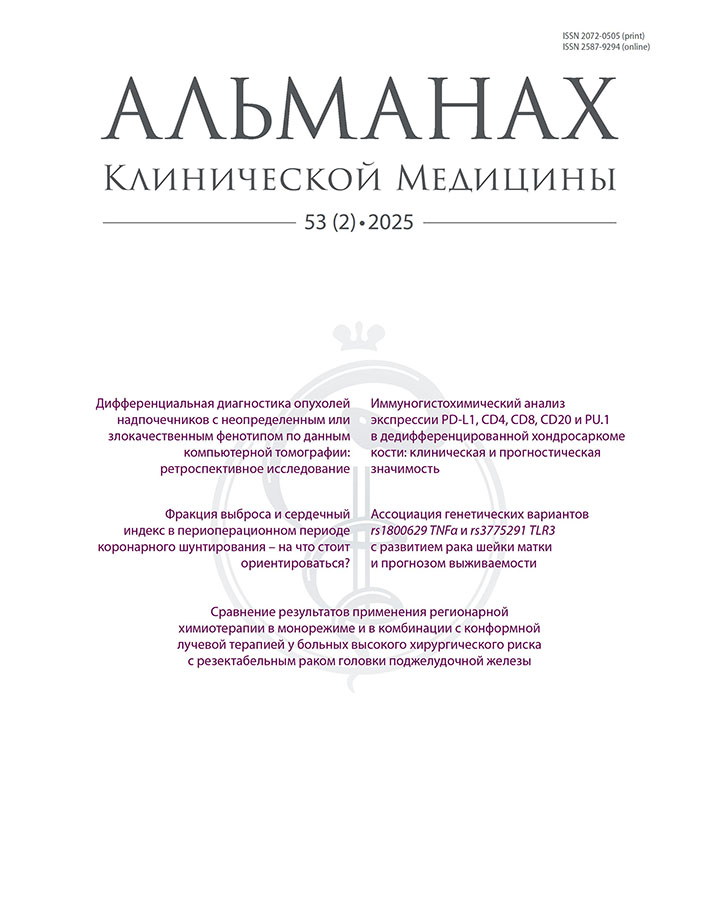Выбор способа формирования пищеводно-кишечного анастомоза после полного удаления желудка
- Авторы: Иванов Ю.В.1,2, Данилина Е.С.2, Истомин Н.П.2, Величко Е.А.2, Мамошин А.В.3, Агибалов Д.Ю.4
-
Учреждения:
- ФГБУ «Федеральный научно-клинический центр специализированных видов медицинской помощи и медицинских технологий ФМБА России»
- Академия постдипломного образования ФГБУ «Федеральный научно-клинический центр специализированных видов медицинской помощи и медицинских технологий ФМБА России»
- ФГБОУ ВО «Орловский государственный университет имени И.С. Тургенева»
- Обнинский институт атомной энергетики – филиал ФГАОУ ВО «Национальный исследовательский ядерный университет «МИФИ»
- Выпуск: Том 48, № 6 (2020)
- Страницы: 437-444
- Раздел: ТОЧКА ЗРЕНИЯ
- URL: https://almclinmed.ru/jour/article/view/1395
- DOI: https://doi.org/10.18786/2072-0505-2020-48-067
- ID: 1395
Цитировать
Полный текст
Аннотация
Статья посвящена различным способам формирования пищеводно-кишечных анастомозов при полном удалении желудка (гастрэктомии). Описаны основные способы ручного и степлерного сшивания пищевода с тощей кишкой. Особое внимание уделено техническим деталям выполнения наиболее распространенных пищеводно-кишечных анастомозов. Приведена сравнительная оценка надежности ручных и степлерных анастомозов. Учитывая большое количество предлагаемых способов формирования пищеводно-кишечных анастомозов, можно утверждать, что универсального анастомоза до сих пор не существует. Наиболее часто при лапаротомии для формирования пищеводно-кишечного анастомоза используют степлерный шов с помощью циркулярных сшивающих аппаратов, а в ручном варианте – одну из методик инвагинационного или муфтообразного соустья (по К.Н. Цацаниди, Г.В. Бондарю, М.И. Давыдову). При лапароскопическом доступе формирование анастомоза выполняют с помощью линейных эндоскопических сшивающих аппаратов. Выбор метода формирования пищеводно-кишечного соустья остается за оперирующим хирургом и зависит от его опыта, навыков, индивидуальной интраоперационной ситуации, оснащения операционного блока.
Об авторах
Ю. В. Иванов
ФГБУ «Федеральный научно-клинический центр специализированных видов медицинской помощи и медицинских технологий ФМБА России»;Академия постдипломного образования ФГБУ «Федеральный научно-клинический центр специализированных видов медицинской помощи и медицинских технологий ФМБА России»
Автор, ответственный за переписку.
Email: ivanovkb83@yandex.ru
ORCID iD: 0000-0001-6209-4194
Иванов Юрий Викторович – доктор медицинских наук, профессор, заведующий отделением хирургии ФГБУ «Федеральный научно-клинический центр специализированных видов медицинской помощи и медицинских технологий ФМБА России»; профессор кафедры хирургии Академия постдипломного образования ФГБУ «Федеральный научно-клинический центр специализированных видов медицинской помощи и медицинских технологий ФМБА России»
115682, г. Москва, Ореховый б-р, 28,
125371, г. Москва, Волоколамское шоссе, 91
Россия
Е. С. Данилина
Академия постдипломного образования ФГБУ «Федеральный научно-клинический центр специализированных видов медицинской помощи и медицинских технологий ФМБА России»
Email: danilina.katja@bk.ru
ORCID iD: 0000-0002-2466-3795
Данилина Екатерина Станиславовна – клинический ординатор кафедры хирургии
125371, г. Москва, Волоколамское шоссе, 91
РоссияН. П. Истомин
Академия постдипломного образования ФГБУ «Федеральный научно-клинический центр специализированных видов медицинской помощи и медицинских технологий ФМБА России»
Email: nistomin46@mail.ru
ORCID iD: 0000-0002-0615-2588
Истомин Николай Петрович – доктор медицинских наук, профессор кафедры хирургии
125371, г. Москва, Волоколамское шоссе, 91
РоссияЕ. А. Величко
Академия постдипломного образования ФГБУ «Федеральный научно-клинический центр специализированных видов медицинской помощи и медицинских технологий ФМБА России»
Email: velichko_eugen@mail.ru
ORCID iD: 0000-0002-0297-8155
Величко Евгений Александрович – кандидат медицинских наук, доцент кафедры хирургии
125371, г. Москва, Волоколамское шоссе, 91
РоссияА. В. Мамошин
ФГБОУ ВО «Орловский государственный университет имени И.С. Тургенева»
Email: dr.mamoshin@mail.ru
ORCID iD: 0000-0002-1799-6778
Мамошин Андриан Валерьевич – кандидат медицинских наук, доцент кафедры общей хирургии и анестезиологии лечебного факультета
302026, г. Орел, ул. Комсомольская, 95
РоссияД. Ю. Агибалов
Обнинский институт атомной энергетики – филиал ФГАОУ ВО «Национальный исследовательский ядерный университет «МИФИ»
Email: agibalovd@bk.ru
ORCID iD: 0000-0003-2995-7140
Агибалов Дмитрий Юрьевич – старший преподаватель кафедры хирургических болезней медицинского факультета
249040, Калужская область, г. Обнинск, Студгородок, 1
РоссияСписок литературы
- Takeshita K, Sekita Y, Tani M. Medium- and long-term results of jejunal pouch reconstruction after a total and proximal gastrectomy. Surg Today. 2007;37(9):754–61. doi: 10.1007/s00595-007-3497-5.
- Волков СВ. Несостоятельность пищеводно-кишечного анастомоза у больных после типовых и комбинированных гастрэктомий: клинические и хирургические аспекты. Вестник Чувашского университета. 2010;(3):80–8.
- Черноусов АФ, Хоробрых ТВ, Левкин ВВ, Ногтев ПВ, Вычужанин ДВ. Несостоятельность швов пищеводно-кишечного анастомоза у пациентов с кардиоэзофагеальным раком. Новости хирургии. 2011;19(4):16–23.
- Волков СВ. Выбор метода формирования пищеводно-кишечного анастомоза после гастрэктомии. Вестник Чувашского университета. 2012;(3):370–4.
- Iwata T, Kurita N, Ikemoto T, Nishioka M, Andoh T, Shimada M. Evaluation of reconstruction after proximal gastrectomy: prospective comparative study of jejunal interposition and jejunal pouch interposition. Hepatogastroenterology. 2006;53(68):301–3.
- Поликарпов СА, Лисицкий АН, Горюнов ИВ, Сулейманов МУ. Выбор метода наложения пищеводно-кишечного анастомоза после гастрэктомии. Хирургия. Журнал им. Н.И. Пирогова. 2008;(9):56–60.
- Роман ЛД, Карачун АМ, Самсонов ДВ, Шостка КГ, Богородский ДЮ, Павленко АН. Отдаленные результаты хирургического лечения больных местно-распространенным раком желудка. Поволжский онкологический вестник. 2010;(4):48–52.
- Хатьков ИЕ, Израилов РЕ, Васнев ОС, Поморцев БА, Семенов НЕ, Быстровская ЕВ, Щадрова ВВ. Лапароскопическая гастрэктомия при местно-распространенном раке желудка. Эндоскопическая хирургия. 2018;24(2):8–12. doi: 10.17116/endoskop20182428.
- Chan BYO, Yau KKW, Chan CKO. Totally laparoscopic versus open gastrectomy for advanced gastric cancer: a matched retrospective cohort study. Hong Kong Med J. 2019;25(1): 30–7. doi: 10.12809/hkmj177150.
- Gong CS, Kim BS, Kim HS. Comparison of totally laparoscopic total gastrectomy using an endoscopic linear stapler with laparoscopic-assisted total gastrectomy using a circular stapler in patients with gastric cancer: A single-center experience. World J Gastroenterol. 2017;23(48):8553–61. doi: 10.3748/wjg.v23.i48.8553.
- Ручкин ВИ, Робак АН, Мысливцев СВ, Осмоналиев БК, Корж СС. Сравнительная характеристика ручного лигатурного и компрессионных никелидтитановых пищеводно-кишечных анастомозов при гастрэктомии. Хирургия. Журнал им. Н.И. Пирогова. 2012;(7):64–9.
- Давыдов МИ, Аксель ЕМ. Злокачественные новообразования в России и странах СНГ в 2012 г. М.: РОНЦ им. H.H. Блохина РАМН; 2014.
- Izbicki JR, Gawad KA, Quirrenbach S, Hosch SB, Breid V, Knoefel WT, Küpper HU, Broelsch CE. Ist die Klammernaht in der Visceralchirurgie noch gerechtfertigt? Eine prospektiv kontrollierte, randomisierte Studie zur Kosteneffektivität von Hand- und Klammernaht [Is the stapled suture in visceral surgery still justified? A prospective controlled, randomized study of cost effectiveness of manual and stapler suture]. Chirurg. 1998;69(7):725–34. German. doi: 10.1007/s001040050481.
- Бойко ВВ, Белозеров ИВ, Новиков ЕА, Невзоров ВП, Савви СА, Андреев ГИ, Жидецкий ВВ. Анализ ультрамикроскопических изменений тканей пищевода в зоне пищеводных анастомозов. Вестник хирургии Казахстана. 2013;2(34):25–8.
- Дамбаев ГЦ, Кошель АП, Соловьев ММ, Куртсеитов НЭ, Попов АМ. Постгастрорезекционные синдромы как проблема реконструктивной хирургии. Вопросы реконструктивной и пластической хирургии. 2012;15(1):51–5.
- Куртсеитов НЭ, Дамбаев ГЦ, Кошель АП, Вусик АН, Соловьев ММ. Применение диафрагмокруротомии по методике А.Г. Савиных при реконструкции пищеводно-кишечного анастомоза после гастрэктомии. Бюллетень Восточно-Сибирского научного центра Сибирского отделения Российской академии медицинских наук. 2015;2(102): 21–4.
Дополнительные файлы








